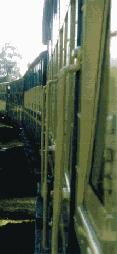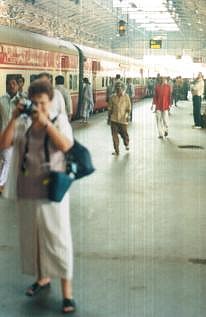Auckland based aesthetic philosopher
Davies even argues that there is no single comprehensive
definition of west-centric art. On the other hand the
Australian Federal Government's Office of Multicultural
Affairs (1989:141) defines art across cultures which it
calls 'Multi cultural Art' as
- 'artistic
achievement which fosters the retention of
traditional art and craft skills and ideas,
increases intercultural understanding, and
contributes to the development of a uniquely
Australian expression of culture.'
|
| Finding agreement on satisfactory
definitions of music may be even more challenging. We
still tend in our schools to place high value on teaching
and learning what are essentially ethnocentric element-based
concepts including 'rhythm', 'melody', 'harmony', 'metre'
and 'co l our', and to read and write staff notation as
essential to music. |
- While there is no
denying that these are critical to understanding
a significant arena of music as western high art
music, school music studies need to embrace music
both parochially and globally. Insisting that
music be written, for example, may deny the value
of its oral transmission, and a focus on musical
'elements' may denigrate the music of cultures
who never indulge in their music as analytical or
intellectual pursuits. To many wor l d peoples
music is integral to living and there may not
even have a separate name for it. Perhaps we
should be less engrossed with what music 'is',
somehow implying that it is unchanging, than with
what music 'does', as it is constantly
reinterpreted, refashioned and transformed.
Swanwick (1979:112)
- 'Music structures
feeling but also impregnates structure with
feeling. It is a merging of subjectivity with
objectivity'.
|
- Musical movement 'is
invested with humanity not merely because music
is created and performed by humans but because it
provides a sense of unity and purpose' (Davies,
1994: 229). The dependency of the organisation or
'Form' of any piece of music on UNITY or 'oneness'
may be music's most universal cultural at tribute.
For this unity directs musical movement and is
subsequently communicated from performer to
listener.
- 'A culturally
agreed upon pattern of rhythm and melody, ie. a
song, that is sung together, provides a shared
form of emotion that, at least durin g the course
of the song, carries along the participants so
that they experience their bodies responding
emotionally in very similar ways. (Storr,1993)'
- Perhaps we need a
more 'Renaissance' view of music which sees it as
an integral part of other disciplines, certainly
at least of the Arts. In fact many cultures do
not separate music from dance, drama, and the
visual arts. In schools dance often ends up being
the 'responsibility' of the PE faculty. I suggest
that it is as ap propriate, if not more
appropriate that it be included in the Arts. But
rather than argue the distinction why not work co-operatively
with other staff to run dance as a joint activity.
Dance certainly supports rhythm activities as the
following dance and movement activities
demonstrate. These are provided to give an
example of ways an imaginative teacher might
encourage students, particularly but not
exclusively in early childhood, to interpret
different rhythms.
|
|
- Riding
the Toy Train
- The famous
'toy train' operates in the
hill country of western Tamil Nadu. It is
pulled by an old steam engine. Use your
imagination to picture the train. Make a
train with the rest of the group and set
off, in time to the music. How will you
create an engine? How will you 'ride' the
train? Where are you going? What will the
surroundings be like on the way... when
you get there?
- When the
music stops freeze! Listen for the number
I call and form a group of that number of
people. (let this happen, then...) extras,
add yourself to a group. (Watch for the
beginning of group interplay, remainders,
etc)
- Now
construct A MACHINE
- When the
music begins again the train reforms.
Make it different if you wish, but set
off until the music stops. Freeze!
- When the
music begins again the train reforms.
Make it different if you wish, but set
off until the music stops. Freeze!
- Now
construct A BRIDGE
- When the
music begins again the train reforms.
Make it different if you wish, but set
off until the music stops. Freeze!
- Now
construct A DINOSAUR
- When the
music begins again the train reforms.
Make it different if you wish, but set
off until the music stops. Hissing of
steam?
|
| |
|
|




